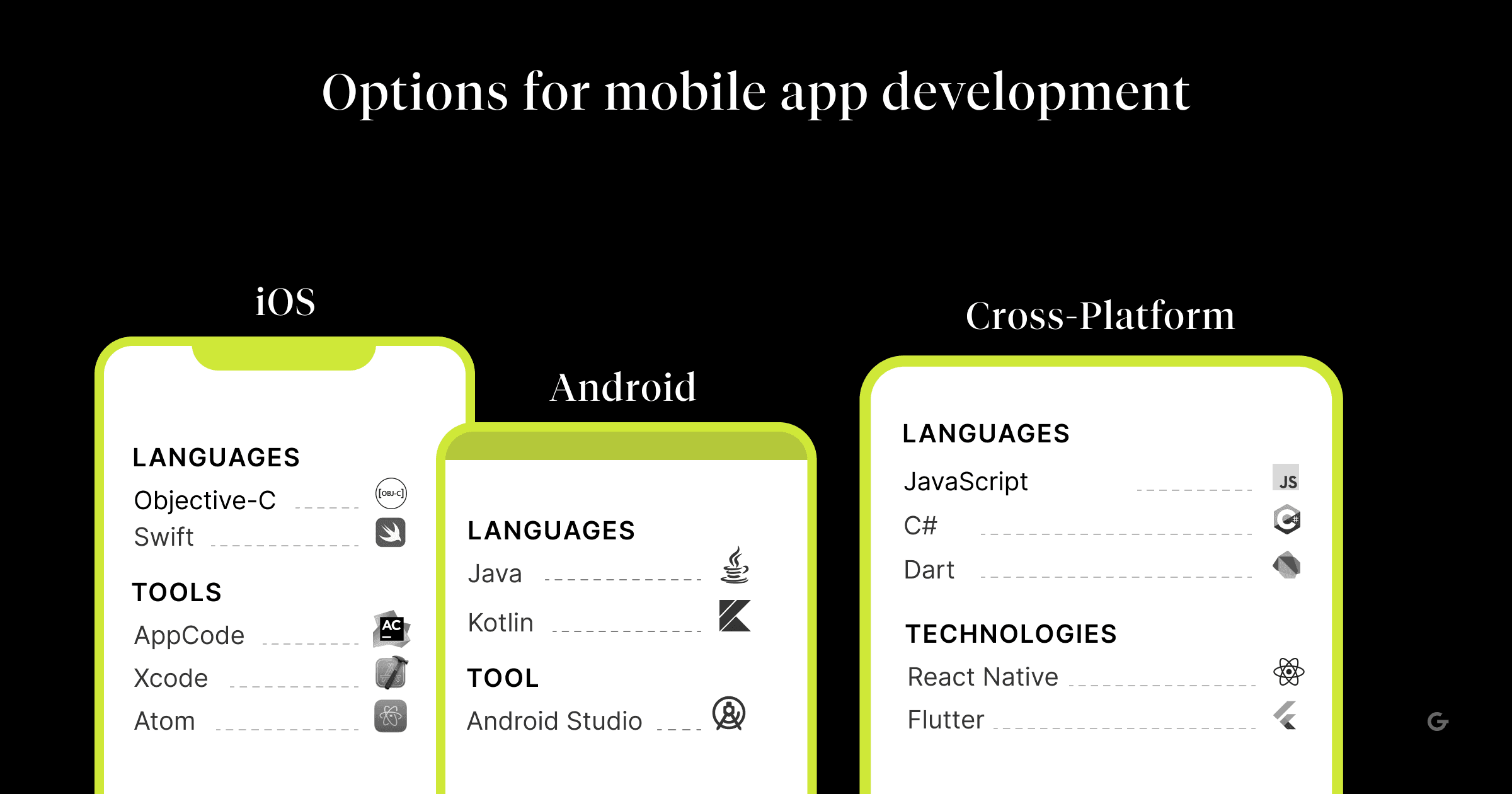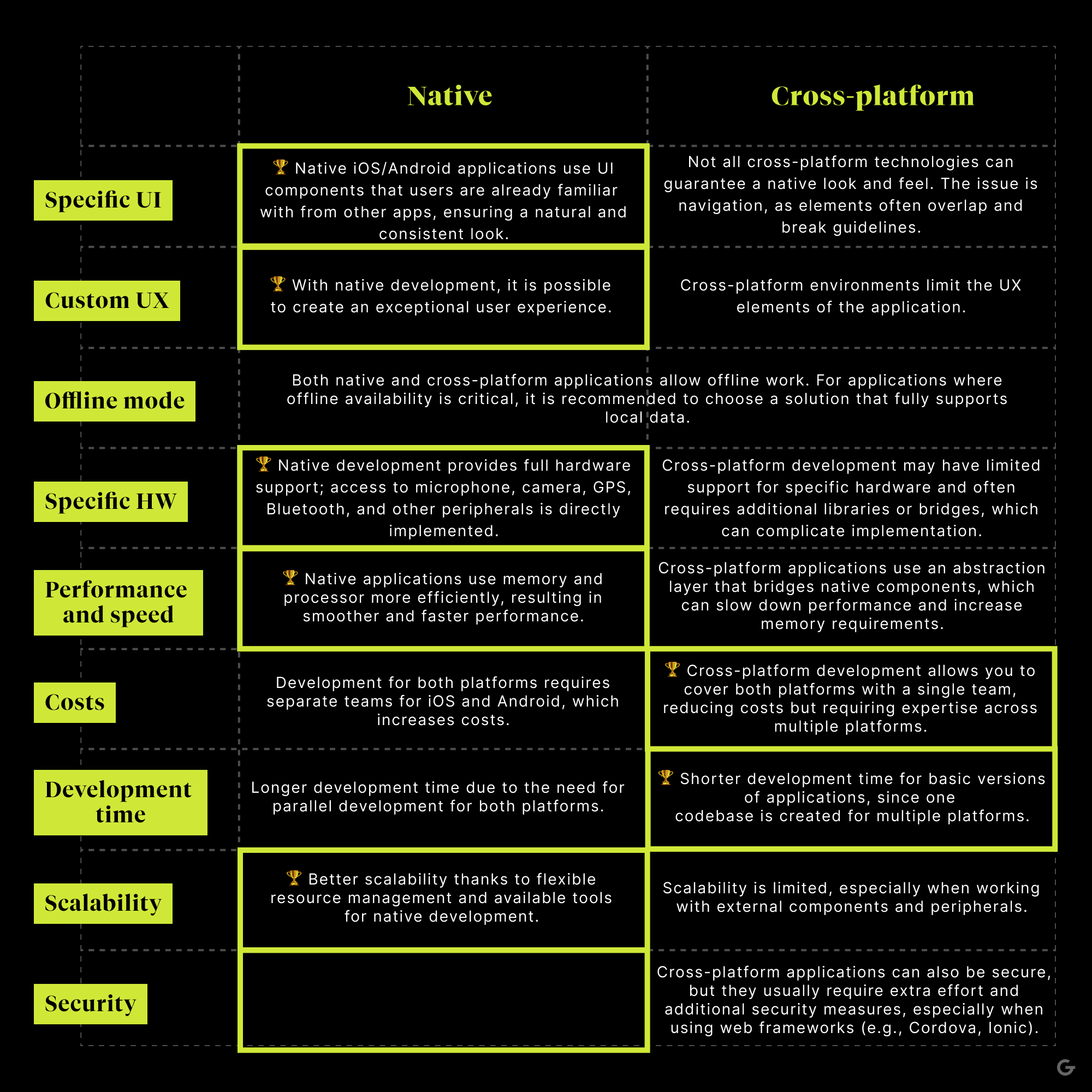
10. Jan 2023Business
Native vs. cross-platform: How to choose the right way for mobile app development?
In the world of mobile applications, there is an "eternal" debate about the ideal development method, and we often get this question from our clients as well. In this article, you will learn the advantages and disadvantages of individual development options, technical and non-technical arguments from the perspective of our developers who have experience with Kotlin, Swift, Flutter and React Native languages.


What are the options for mobile app development?
Native development
Native applications are developed for a specific platform , for example iOS or Android. The programming language used to create these applications is compatible with the operating system. By using platform-specific languages, developers can take better advantage of the platform's native features. So an app made for Android won't work on Apple devices.
- 🤖 Android: Kotlin, Java
Development environment: Android Studio - 🍏 iOS: Swift, Objective-C
Development environment : Xcode
Cross-platform
The cross-platform approach to mobile application development allows you to create a single application that works equally well on multiple operating systems . This means you don't have to create separate versions for each individual platform.
- Cross-platform: Ionic, React Native, Flutter, Cordova, KMM

Why prefer cross-platform development?
Cross-platform frameworks like Flutter, React Native and KMM have undergone significant evolution:
- Flutter since version 3.x brings better support for native features, including accessibility and biometrics.
- React Native uses native components, improving UX and reducing differences from native apps.
- KMM, a technology from JetBrains that allows common code (business logic, network communication, data layers) to be shared between Android and iOS, with the UI being developed natively for each platform with the ability to use Android Studio and Xcode.
- HW support has improved, but native implementation may still be needed for very specific cases.
- Support for these frameworks is active and regular updates are ongoing.
Why prefer native development?
We have been dedicated to native development since the very beginning, during that time we have encountered many implementations of native libraries, work with augmented reality, camera, video, Bluetooth, NFC scanners, security, widgets and many other options offered by iOS and Android platforms. Our expertise in native development is therefore not only at the level of programming languages, but also the integration of third-party hardware and software.
SwiftUI* and its Previews in native development greatly simplifies and speeds up UI* development compared to UIKit*. The Preview feature in Xcode allows developers to instantly see the result of UI changes without having to run the application on a simulator or physical device, which also greatly increases productivity.
- *UI - User Interface.
- *SwiftUI - a declarative framework from Apple that has become the standard for creating user interfaces in recent years.
- *UIKit - an older framework for iOS app development, development in it requires more code and manual administration.
On the Android side, native development is greatly accelerated by Jetpack Compose, which is a declarative UI framework similar to SwiftUI. Jetpack Compose enables rapid development of modern UIs with support for live previews directly in Android Studio, increasing productivity and quality of user experience.
Almost all well-known and popular applications used by a large number of users are built on native technologies. From the point of view of the business model, the "durability" of technologies is important. Cross-platform technologies such as Flutter change extremely dynamically, while React native or some third-party libraries are stagnant, which can lead to incompatibilities when building an application. All these factors can lead to various problems such as development delays, unavailability of developers or use of outdated technologies.
However, we realize that in some business cases cross-platform development can be the right way, it is important to decide based on the key parameters resulting from your business strategy . That is why we have prepared the key areas of design and development, including the benefits and risks of individual forms of development.
What parameters to consider when choosing an approach to creating a mobile application?
UX & UI – Native still slightly ahead, cross-platform has made significant progress
Users are looking for apps that look and feel like they belong on their device. Native iOS and Android apps are built using UI components that users are used to from other native apps, creating a natural yet exceptional user experience.
However, cross-platform frameworks have advanced considerably in recent years. React Native has significantly reduced the difference between native and cross-platform UI/UX. It uses native components, is more scalable, and supports most modern accessibility features (such as font enlargement and voice-over). Flutter, like React Native, supports accessibility, although some features may require additional configuration. Support for font enlargement, high contrast, and voice control is now standard.

Differences in look and feel are decreasing. For applications where the UI/UX experience is key, native development still has a slight advantage.
Offline mode - Draw
Going offline can be a big competitive advantage. Even if users are happy with your app, the lack of offline features may make them look for alternatives. Offline functions are important, for example, in fintech, healthcare or navigation. Both native and cross-platform applications allow working in offline mode.
Specific HW – Native
Using cross-platform development can result in limited support and increases the likelihood of hardware-specific integration flaws. If we need access to it, native development is faster and easier. Every library, application or hardware has support for native development first and foremost. Which helps ensure seamless integration of the new product into the existing infrastructure.
Application performance and speed - Native
Native iOS apps work with RAM much more efficiently, making apps more responsive. From a technical point of view, Flutter uses a Garbage collector and the entire development for iOS is based on automatic reference counting (ARC), which is much more efficient when working with memory, thanks to which native iOS applications use 1/3 of the RAM compared to Flutter. The need for an additional abstraction layer and rendering process makes a cross-platform application slower.
The problem is primarily with all frameworks that use bridge* or run completely in WebView* (Ionic, Cordova). Applications that use to communicate with bridge platforms have an automatically assigned bottleneck* , which is extremely sensitive in many cases. At the same time, they use native components, so libraries in these frameworks can easily have different versions of native libraries, causing huge conflicts in the native part.
- * bridge – a mechanism that enables communication and cooperation of different programming languages or technologies. In this context, a bridge connects two different parts of an application and allows them to share data and functionality.
- *WebView - a component used in mobile development to display a web page in an application.
- *bottleneck – bottleneck or component that limits the speed and overall performance of the application.
The technology used also has a big impact on the size of the application itself. For iOS apps, we can talk about 1/2 the size of an app developed in Swift compared to Flutter.
Costs - Cross-platform
Cross-platform applications are a great way to reduce costs and increase efficiency, which is definitely one of the main benefits worth considering. Developing native apps can be expensive due to cross-platform development. In translation, you will need a team for each platform - for example, one for iOS and one for Android. In this case, instead of two teams of developers, you will only need one to create a Cross-platform application. ⚠️ However, this team will need to have experience developing for both platforms.
Duration of development - Cross-platform
A single development process is all it takes to create a "base" version of your app that works across multiple platforms, so you can bring your mobile app to market faster . However, it is important to mention that although the development itself is faster, testing such applications takes just as much time.
The main problem in the development and maintenance of a cross-platform application is the substitutability of people. Especially for smaller development contractors, the departure of a developer can cause a serious problem.
Scalability – Native
Applications built in a native environment are usually more scalable due to the flexibility of resource management and the number of available tools . Conversely, in cross-platform development, scaling options are significantly limited, especially when working with third-party interfaces and peripherals.
- Push notifications - and their behavior after opening, routing to different application screens. The processing of push notifications on the device is subject to the rules of the given platform. On Android, it is necessary to solve the classification of received notifications into common groups, or the assignment of the importance of the notification. These are just examples of rules that change with new versions of Android and iOS, and when meeting these cross-platform conditions, development becomes more complicated.
- Advertising models - the current trend on Google is to sell ads using Admob, mainly because Google is able to target ads on its platform effectively. However, the same does not apply to iOS, which in the latest versions tries to anonymize the user as much as possible and thus takes up space for targeted advertising.
- Integration with Peripherals - From a technical point of view, there are no restrictions for native development. During cross-platform development, developers may have problems accessing smartphone functions such as microphone, camera, geolocation or Bluetooth. At the same time, native development enables working with a high frequency of frames per second when processing video or audio.
Safety - Draw
Security has long been the number one topic in the digital world, and it shouldn't be any different for app developers and businesses. Security must be carefully considered for cross-platform applications based on web technologies (HTML, CSS, JavaScript). They may be more vulnerable to attacks such as cross-site scripting or injection attacks. On the other hand, native applications have better integration with the system's security features.
Our experience
Our team has been dedicated to native development since the very beginning. During this time, we had the opportunity to work on projects where we encountered many implementations of native libraries, work with augmented reality, camera, video, Bluetooth, NFC scanner, security, widgets and many other options offered by the iOS and Android platforms. Our expertise in native development is therefore not only at the level of programming languages, but also the integration of many third-party hardware and software.
During our practice, we encountered various cross-platform development options, which we had the opportunity to test, but unfortunately they could not replace completely native development, and therefore knowledge of native technologies was also necessary.
We also consider the already mentioned factors as essential, such as sustainability, replaceability of developers and suppliers, guaranteed support and compatibility, extensibility to other devices, better performance and scalability.
Tatra banka - Banking application of the year
The native development of the mobile application for both iOS and Android allows us to regularly bring innovations while maintaining the performance of the application, scalability and the best possible mobile experience, which is why Tatra Bank's mobile banking is considered the most innovative on the Slovak market.
Native development also allows us to easily log into the app using face and fingerprint thanks to the integration of modern biometrics from the market leader Innovatrics. The complex package of Innovatrics technologies for online authentication also includes detection and authentication of data from identity documents (ID), NIST FRVT facial biometrics or accredited iBeta Level 2 liveness detection, which is an effective part of preventing identity misuse, which is a must in the fintech sector. It goes without saying that the application can be customized not only for iOS and Android, but also for different screen sizes.
Benu - Online pharmacy innovation
The goal when creating an online mobile pharmacy for Benu was to create the simplest and most understandable user experience possible, while maintaining all the functionalities that we mapped out with the client, so it was necessary to create applications for Android and iOS platforms natively.
The main advantages of using native development in this case are higher application security, compliance with pharmaceutical legislation, better user experience and integration of native libraries. For example, the user can add a recipe via the camera, from a photo or via SMS.
So which option is ideal from the point of view of individual factors?

So on what basis to decide?
We certainly do not reject cross-platform applications, there are many situations in which it is more effective to consider these approaches, when?
When to prioritize cross-platform development?
- If you want to quickly test an idea or create an MVP and enter the market with a functional product as soon as possible.
- When you need to cover multiple platforms on a limited budget and reduce development and maintenance costs.
- If the application does not have extremely complex features, performance requirements, or detailed native UX elements.
- When you expect easier maintenance and less complicated code management within a single team.
- If the application is not a key product of your business, but rather a supplement or extension of your core services.
When to prioritize native development?
- When the application is the product itself or the basis of your business, and its quality/UX/security determine its success.
- If there is strong competition in the segment and every detail of design, performance, or UX is a competitive advantage.
- When the application requires high memory management, complex and specific user interfaces, or animations.
- If you need full access to native operating system features and specific hardware.
- When you need to maximize security and protection of sensitive company and customer data.
- If it is crucial to provide a complex and flawless UX, including offline mode, which must work reliably even without a connection.
- If your product requires faster and easier implementation of updates for new complex features.
Both approaches have their advantages and limitations. Our goal is to create high-quality digital products that leverage the strengths of each platform, which is why we choose the technology based on the specific needs of the project.


Related articles

How to build AI solutions that deliver 10× more value for your business


Importance of analysts in successful software projects


How we approach estimations
